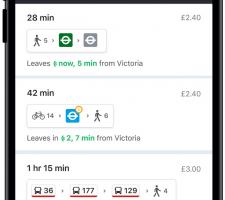
Launching mobility services without taking into account public transportation data can lead to chaos in cities. That’s the view of Alon Shantzer, vice president international sales at
“The data we have can define how and where to implement these services,” Shantzer says. Speaking to ITS International at the ITS European Congress in Eindhoven, Netherlands, he revealed that the company has just entered into such an agreement with Microsoft and Uber.
“We are providing public transportation data for Microsoft’s Azure maps and for Uber’s public transportation service,” he continues. “Our goal is to help commuters and be the multimodal engine behind services like Microsoft and Uber, and to provide MaaS solutions for cities and municipality operators.”
He reveals that the public transportation data is bolstered by a community of more than half a million people.
“These people are voluntarily helping to build our community,” he beams. “Having analogue data to make it digital using our tools, while we are able to give the Moovit service the free app in the region, so people are doing it to help their community, parents and children.”
Early revolution
Moovit was the official transit app for Brazilian city Rio de Janeiro during the 2016 Olympics. Yet despite the ubiquity of transit apps, the transport industry is near the beginning of this revolution in the way we travel, and there is still much to explore. For example, Moovit carried out a case study in the Italian city of Milan which revealed that using a current mobility service in a different way “will dramatically impact the usage of public transportation”.
“In Milan, a bus travelling from the main train station to a shopping mall will take 45 minutes travelling along long routes,” explains Shantzer. “And the data shows that no-one actually goes from those stations. Implementing an on-demand shuttle in this area would help to reduce the journey to 20 minutes.”
Shantzer claims that most on-demand shuttles are driving around with just one passenger but Moovit’s data can determine how many vehicles are needed in a given area, in order to make the service more cost-effective.
Shantzer warns that another issue arises when municipalities try to provide a solution that is “not as good as it should be and then have difficulty getting the demand because not a lot of people download it”.
He also recognises that MaaS deployment is dependent on the region, describing Europe as being more advanced in integrating public transportation and micromobility than the US. Even so, North America is now also starting to head in this direction, he believes: “I think that eventually once MaaS becomes more dominant and will have demand from the users, micromobility will have to jump on the same platform to be part of it and not beside it.”
AV move
Shantzer claims there is a big move in Europe to have MaaS solutions owned by the cities and there is a race in the market over who will become dominant in MaaS in order to be ready for autonomous vehicles (AV).
“You won’t care what will come to pick you up, and whoever is going to have the most demand will be the dominant service for citizens. We will then move from owning cars to using it more as a service in areas such as car-sharing, bike-sharing and AVs.”
While admitting that MaaS will not be for everyone, Shantzer remains confident in Moovit’s app, emphasising that it allows users to tailor their journeys for specific needs – for example, to only include trips with buses and trains or stations which provide wheelchairs or which have wheelchair access.
“We provide the MaaS solution based on the Moovit platform with all the features such as accessibility for everyone to use transportation or means of transportation in the city.”
Going forward, he recommends that policymakers establish more open regulation to help companies like Moovit deliver MaaS in a more proper way. He doesn’t believe that letting the free market make all the running is necessarily the way to go.
“Municipalities should also take more ownership in projects instead of letting the private industry to do their own thing,” he suggests. “They can do that by consulting and working with these companies instead of trying to re-invent the wheel as some of them are trying to develop solutions from scratch.”
Shantzer says Moovit is working toward reaching one billion users in the coming months and intends to focus on operating MaaS solutions.
US and them?
Alon Shantzer’s insight into why Europe may be better equipped for MaaS than the US ties into a report published by Juniper Research which found that western Europe will lead the way by accounting for 83% of global MaaS trips (‘Tipping Points’, ITS International November-December 2018).
The report, Mobility as a Service: Emerging Opportunities, Vendor Strategies & Market Forecasts 2018-2023, said Finnish capital Helsinki will lead MaaS implementation, followed by Stockholm, Sweden and Vienna, Austria.
Helsinki is where MaaS Global’s Whim app is in operation. Research author Nick Maynard says the city’s winning position is a result of collaboration between the country’s government and MaaS vendors.
However, in the US MaaS is predicted to grow more slowly due to what Juniper describes as a fragmented state and federal system, combined with ‘lukewarm’ legislative support for regulation. In addition, a current lack of federal concern over environmental issues means that one major driver for the deployment of MaaS – the green agenda - is not present in the same way in the US.






